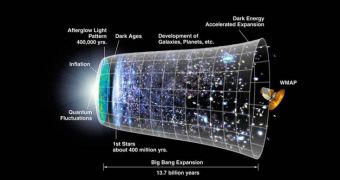A team of astronomers reveals a new method of analyzing the way the Universe looked like during its dark ages. Since there was no light in the Cosmos at that time, there is no way to analyze it, except looking at the leftover glow left behind by the most ancient stars that ever appeared.
After the Big Bang took place, some 13.7billion years ago, the Cosmos expanded rapidly, consisting of an amorphous mass of hydrogen gas, in various state of matter. It was only several hundred million years later that the earliest stars began forming.
The first stars to appear were most likely massive ones, astrophysicists say, because the conditions were right to support their development. But massive stars exhaust their fuel supply in just a few million years, and so these objects quickly went supernova, and formed large black holes.
The time that passed between the Big Bang and the appearance of light emanating from the earliest stars is called the Universal dark age. Experts from the University of Cambridge and the California Institute of Technology (Caltech) have been analyzing it for years.
One of the main objectives for such studies is determining how the Universe got converted from being a space filled with hydrogen and helium to a place that contained heavier chemical elements, including carbon, oxygen and iron.
In order to find out more data about this missing evolutionary link in the history of the chemical Cosmos, experts are using light that was emitted billions of years ago by quasars to “light up” gases released by early stars.
These celestial fireballs exploded billions of years ago, but their emissions may still endure. Using the radiation of quasi-stellar radio sources, the cores of active galaxies, astronomers hope to gain more insight into the chemical evolution of the Universe.
“We have effectively been able to peer into the dark ages using the light emitted from a quasar in a distant galaxy billions of years ago,” explains scientist Max Pettini.
The expert, who is based at Cambridge's Institute of Astronomy (IoA), was the leader of the new research effort, alongside PhD student Ryan Cooke.
“The light provides a backdrop against which any gas cloud in its path can be measured. As judged by its composition, the gas is a remnant of a star that exploded as much as 13 billion years ago,” he says.
“It provides the first analysis of the interior of one of the universe's earliest stars,” the expert adds, saying that the analysis provided the team with some clues as to how the Universe evolved.
“We discovered tiny amounts of elements present in the cloud in proportions that are very different from their relative proportions in normal stars today,” Pettini says.
“Most significantly, the ratio of carbon to iron is 35 times greater than measured in the Sun. The composition enables us to infer that the gas was released by a star 25 times more massive than the Sun and originally consisting of only hydrogen and helium,” the scientist explains.
“In effect this is a fossil record that provides us with a missing link back to the early Universe,” he concludes. Details of the work appear in the latest issue of the esteemed journal Monthly Notices of the Royal Astronomical Society.

 14 DAY TRIAL //
14 DAY TRIAL //